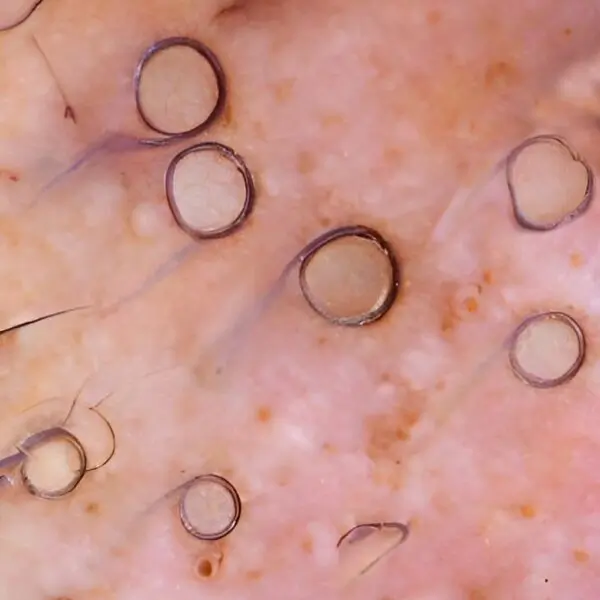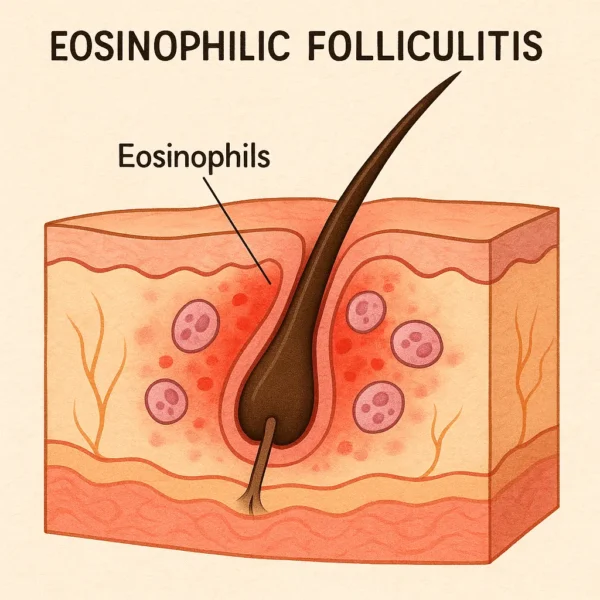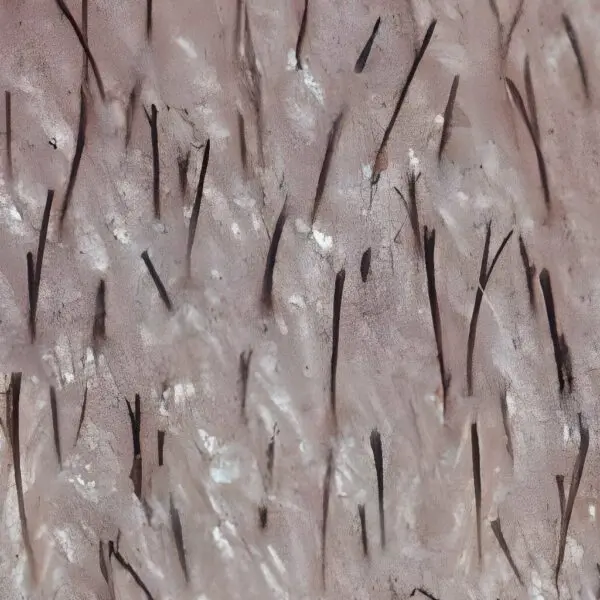Circle hairs, also referred to as spiral hairs, represent a fascinating and somewhat under-discussed topic within the domain of dermatology, specifically within the study of hair disorders. This article delves into the nuances of circle hairs, exploring their definition, epidemiology, pathogenesis, clinical presentation, diagnosis, and management strategies. By providing a comprehensive overview, we intend to shed light on this condition, offering insights for both clinical practitioners and researchers in the field of hair and skin disease.
Definition: Circle hairs are a peculiar type of hair disorder characterized by the growth of hairs in a tightly coiled or spiral fashion beneath the stratum corneum, the outermost layer of the skin. The coils have a diameter of one to three millimeters and can be scratched out with a fingernail. When the hair is pulled out straight andthen let go it springs back into its original shape. Unlike ingrown hairs, which typically result from the hair growing back into the skin and causing inflammation, circle hairs do not usually penetrate the skin dermis or lead to significant inflammatory responses. The condition was first described in the medical literature in the late 20th century.
Pathogenesis: The precise mechanisms underlying the development of circle hairs remain somewhat elusive. However, several theories have been proposed to explain their formation. One prevailing theory suggests that a defect in the hair follicle’s growth direction may lead to the hair growing horizontally or in a spiral fashion, trapped within the epidermis. Genetic factors may play a role in predisposing individuals to this condition, though environmental influences and personal care practices could also contribute to its manifestation.
Clinical Presentation: Clinically, circle hairs are most commonly observed in areas where the hair is subject to friction or pressure, such as the thighs, buttocks, and lower back. They appear as small, darkly pigmented spots that may be mistaken for comedones (plugged pores) or other skin lesions. Circle hairs are typically asymptomatic, though some individuals may experience mild irritation or discomfort, particularly if the area is subject to repeated friction.
Diagnosis: The diagnosis of circle hairs is primarily clinical, based on the characteristic appearance of the lesions and the exclusion of other similar conditions, such as ingrown hairs, folliculitis, and dermatitis. Dermoscopy, a non-invasive skin examination technique, can aid in the diagnosis by revealing the coiled hair beneath the skin’s surface without the need for a biopsy. In uncertain cases, a biopsy may be performed to rule out other dermatological conditions.
Etiology: While the condition is considered relatively rare across the whole population, its exact prevalence is challenging to ascertain due to underreporting and the benign nature of the disorder. Spiral hairs seem to be a more common phenomenon in middle aged and older men. In one survey 16 of 100 men were observed to have spiral hairs. While they are most frequently found on the back, abdomen and thighs, they usually do not indicate any disease as such.
Management: The management of circle hairs is generally conservative, focusing on symptom relief and prevention of new lesions. Recommendations may include wearing loose-fitting clothing to reduce friction, maintaining proper hygiene, and avoiding excessive manipulation of the affected areas. For individuals experiencing irritation or discomfort, topical treatments such as moisturizers or mild corticosteroids may provide relief. In cases where circle hairs are associated with significant distress or cosmetic concerns, laser hair removal has been proposed as a potential treatment option, though evidence supporting its efficacy is limited.
Conclusion: Circle hairs, while often considered a minor and benign condition, represent an intriguing subject of study within dermatology. The exact pathogenesis remains a topic of ongoing research, and further studies are needed to elucidate the genetic, environmental, and physiological factors contributing to their formation. For clinicians, awareness of this condition is essential for accurate diagnosis and effective management, particularly in differentiating circle hairs from more common hair and skin disorders. As our understanding of circle hairs continues to evolve, it is hoped that future advancements will offer improved strategies for prevention and treatment, enhancing the quality of care for individuals affected by this unique hair growth pattern.
Bibliography
11711645 {11711645:FNB99K6S},{11711645:R6PHGQM8},{11711645:TFBKSTMC},{11711645:FBWMDB8M},{11711645:KCC66SZI},{11711645:RHWH8CGP},{11711645:KN68U6J2},{11711645:C3KIT9SX},{11711645:M5RRP5MC},{11711645:RK8Q3SRN},{11711645:96FXGGWC},{11711645:HZKTM92A},{11711645:DQ9HD4VH} 1 vancouver 50 date asc 1189 https://www.keratin.com/wp-content/plugins/zotpress/ %7B%22status%22%3A%22success%22%2C%22updateneeded%22%3Afalse%2C%22instance%22%3Afalse%2C%22meta%22%3A%7B%22request_last%22%3A0%2C%22request_next%22%3A0%2C%22used_cache%22%3Atrue%7D%2C%22data%22%3A%5B%7B%22key%22%3A%22FNB99K6S%22%2C%22library%22%3A%7B%22id%22%3A11711645%7D%2C%22meta%22%3A%7B%22creatorSummary%22%3A%22Adatto%22%2C%22parsedDate%22%3A%221963%22%2C%22numChildren%22%3A0%7D%2C%22bib%22%3A%22%26lt%3Bdiv%20class%3D%26quot%3Bcsl-bib-body%26quot%3B%20style%3D%26quot%3Bline-height%3A%201.35%3B%20%26quot%3B%26gt%3B%5Cn%20%20%26lt%3Bdiv%20class%3D%26quot%3Bcsl-entry%26quot%3B%20style%3D%26quot%3Bclear%3A%20left%3B%20%26quot%3B%26gt%3B%5Cn%20%20%20%20%26lt%3Bdiv%20class%3D%26quot%3Bcsl-left-margin%26quot%3B%20style%3D%26quot%3Bfloat%3A%20left%3B%20padding-right%3A%200.5em%3B%20text-align%3A%20right%3B%20width%3A%201em%3B%26quot%3B%26gt%3B1.%26lt%3B%5C%2Fdiv%26gt%3B%26lt%3Bdiv%20class%3D%26quot%3Bcsl-right-inline%26quot%3B%20style%3D%26quot%3Bmargin%3A%200%20.4em%200%201.5em%3B%26quot%3B%26gt%3BAdatto%20R.%20Poils%20en%20spirale%20%28poils%20enroul%26%23xE9%3Bs%29.%20Dermatologica.%201963%3B127%3A145%26%23x2013%3B7.%26lt%3B%5C%2Fdiv%26gt%3B%5Cn%20%20%20%26lt%3B%5C%2Fdiv%26gt%3B%5Cn%26lt%3B%5C%2Fdiv%26gt%3B%22%2C%22data%22%3A%7B%22itemType%22%3A%22journalArticle%22%2C%22title%22%3A%22Poils%20en%20spirale%20%28poils%20enroul%5Cu00e9s%29%22%2C%22creators%22%3A%5B%7B%22creatorType%22%3A%22author%22%2C%22firstName%22%3A%22R.%22%2C%22lastName%22%3A%22Adatto%22%7D%5D%2C%22abstractNote%22%3A%22%22%2C%22date%22%3A%221963%22%2C%22language%22%3A%22fre%22%2C%22DOI%22%3A%22%22%2C%22ISSN%22%3A%220011-9075%22%2C%22url%22%3A%22%22%2C%22collections%22%3A%5B%22C9ATSQHP%22%5D%2C%22dateModified%22%3A%222024-02-12T17%3A16%3A50Z%22%7D%7D%2C%7B%22key%22%3A%22KN68U6J2%22%2C%22library%22%3A%7B%22id%22%3A11711645%7D%2C%22meta%22%3A%7B%22creatorSummary%22%3A%22Levit%20and%20Scott%22%2C%22parsedDate%22%3A%221983-03%22%2C%22numChildren%22%3A0%7D%2C%22bib%22%3A%22%26lt%3Bdiv%20class%3D%26quot%3Bcsl-bib-body%26quot%3B%20style%3D%26quot%3Bline-height%3A%201.35%3B%20%26quot%3B%26gt%3B%5Cn%20%20%26lt%3Bdiv%20class%3D%26quot%3Bcsl-entry%26quot%3B%20style%3D%26quot%3Bclear%3A%20left%3B%20%26quot%3B%26gt%3B%5Cn%20%20%20%20%26lt%3Bdiv%20class%3D%26quot%3Bcsl-left-margin%26quot%3B%20style%3D%26quot%3Bfloat%3A%20left%3B%20padding-right%3A%200.5em%3B%20text-align%3A%20right%3B%20width%3A%201em%3B%26quot%3B%26gt%3B1.%26lt%3B%5C%2Fdiv%26gt%3B%26lt%3Bdiv%20class%3D%26quot%3Bcsl-right-inline%26quot%3B%20style%3D%26quot%3Bmargin%3A%200%20.4em%200%201.5em%3B%26quot%3B%26gt%3BLevit%20F%2C%20Scott%20MJ.%20Circle%20hairs.%20J%20Am%20Acad%20Dermatol.%201983%20Mar%3B8%283%29%3A423%26%23x2013%3B5.%26lt%3B%5C%2Fdiv%26gt%3B%5Cn%20%20%20%26lt%3B%5C%2Fdiv%26gt%3B%5Cn%26lt%3B%5C%2Fdiv%26gt%3B%22%2C%22data%22%3A%7B%22itemType%22%3A%22journalArticle%22%2C%22title%22%3A%22Circle%20hairs%22%2C%22creators%22%3A%5B%7B%22creatorType%22%3A%22author%22%2C%22firstName%22%3A%22F.%22%2C%22lastName%22%3A%22Levit%22%7D%2C%7B%22creatorType%22%3A%22author%22%2C%22firstName%22%3A%22M.%20J.%22%2C%22lastName%22%3A%22Scott%22%7D%5D%2C%22abstractNote%22%3A%22%22%2C%22date%22%3A%221983-03%22%2C%22language%22%3A%22eng%22%2C%22DOI%22%3A%2210.1016%5C%2Fs0190-9622%2883%2980334-x%22%2C%22ISSN%22%3A%220190-9622%22%2C%22url%22%3A%22%22%2C%22collections%22%3A%5B%22C9ATSQHP%22%5D%2C%22dateModified%22%3A%222024-02-12T17%3A12%3A13Z%22%7D%7D%2C%7B%22key%22%3A%22KCC66SZI%22%2C%22library%22%3A%7B%22id%22%3A11711645%7D%2C%22meta%22%3A%7B%22creatorSummary%22%3A%22Happle%22%2C%22parsedDate%22%3A%221996%22%2C%22numChildren%22%3A0%7D%2C%22bib%22%3A%22%26lt%3Bdiv%20class%3D%26quot%3Bcsl-bib-body%26quot%3B%20style%3D%26quot%3Bline-height%3A%201.35%3B%20%26quot%3B%26gt%3B%5Cn%20%20%26lt%3Bdiv%20class%3D%26quot%3Bcsl-entry%26quot%3B%20style%3D%26quot%3Bclear%3A%20left%3B%20%26quot%3B%26gt%3B%5Cn%20%20%20%20%26lt%3Bdiv%20class%3D%26quot%3Bcsl-left-margin%26quot%3B%20style%3D%26quot%3Bfloat%3A%20left%3B%20padding-right%3A%200.5em%3B%20text-align%3A%20right%3B%20width%3A%201em%3B%26quot%3B%26gt%3B1.%26lt%3B%5C%2Fdiv%26gt%3B%26lt%3Bdiv%20class%3D%26quot%3Bcsl-right-inline%26quot%3B%20style%3D%26quot%3Bmargin%3A%200%20.4em%200%201.5em%3B%26quot%3B%26gt%3BHapple%20R.%20Cilium%20circinatum%20%28circle%20lash%2C%20ringelwimper%2C%20cil%20enroul%26%23xE9%3B%29.%20Dermatology.%201996%3B192%283%29%3A292.%26lt%3B%5C%2Fdiv%26gt%3B%5Cn%20%20%20%26lt%3B%5C%2Fdiv%26gt%3B%5Cn%26lt%3B%5C%2Fdiv%26gt%3B%22%2C%22data%22%3A%7B%22itemType%22%3A%22journalArticle%22%2C%22title%22%3A%22Cilium%20circinatum%20%28circle%20lash%2C%20ringelwimper%2C%20cil%20enroul%5Cu00e9%29%22%2C%22creators%22%3A%5B%7B%22creatorType%22%3A%22author%22%2C%22firstName%22%3A%22R.%22%2C%22lastName%22%3A%22Happle%22%7D%5D%2C%22abstractNote%22%3A%22%22%2C%22date%22%3A%221996%22%2C%22language%22%3A%22eng%22%2C%22DOI%22%3A%2210.1159%5C%2F000246391%22%2C%22ISSN%22%3A%221018-8665%22%2C%22url%22%3A%22%22%2C%22collections%22%3A%5B%22C9ATSQHP%22%5D%2C%22dateModified%22%3A%222024-02-12T17%3A14%3A32Z%22%7D%7D%2C%7B%22key%22%3A%22DQ9HD4VH%22%2C%22library%22%3A%7B%22id%22%3A11711645%7D%2C%22meta%22%3A%7B%22creatorSummary%22%3A%22Smith%20and%20Hogan%22%2C%22parsedDate%22%3A%221996-10%22%2C%22numChildren%22%3A0%7D%2C%22bib%22%3A%22%26lt%3Bdiv%20class%3D%26quot%3Bcsl-bib-body%26quot%3B%20style%3D%26quot%3Bline-height%3A%201.35%3B%20%26quot%3B%26gt%3B%5Cn%20%20%26lt%3Bdiv%20class%3D%26quot%3Bcsl-entry%26quot%3B%20style%3D%26quot%3Bclear%3A%20left%3B%20%26quot%3B%26gt%3B%5Cn%20%20%20%20%26lt%3Bdiv%20class%3D%26quot%3Bcsl-left-margin%26quot%3B%20style%3D%26quot%3Bfloat%3A%20left%3B%20padding-right%3A%200.5em%3B%20text-align%3A%20right%3B%20width%3A%201em%3B%26quot%3B%26gt%3B1.%26lt%3B%5C%2Fdiv%26gt%3B%26lt%3Bdiv%20class%3D%26quot%3Bcsl-right-inline%26quot%3B%20style%3D%26quot%3Bmargin%3A%200%20.4em%200%201.5em%3B%26quot%3B%26gt%3BSmith%20JB%2C%20Hogan%20DJ.%20Circle%20hairs%20are%20not%20rolled%20hairs.%20J%20Am%20Acad%20Dermatol.%201996%20Oct%3B35%284%29%3A634%26%23x2013%3B5.%26lt%3B%5C%2Fdiv%26gt%3B%5Cn%20%20%20%26lt%3B%5C%2Fdiv%26gt%3B%5Cn%26lt%3B%5C%2Fdiv%26gt%3B%22%2C%22data%22%3A%7B%22itemType%22%3A%22journalArticle%22%2C%22title%22%3A%22Circle%20hairs%20are%20not%20rolled%20hairs%22%2C%22creators%22%3A%5B%7B%22creatorType%22%3A%22author%22%2C%22firstName%22%3A%22J.%20B.%22%2C%22lastName%22%3A%22Smith%22%7D%2C%7B%22creatorType%22%3A%22author%22%2C%22firstName%22%3A%22D.%20J.%22%2C%22lastName%22%3A%22Hogan%22%7D%5D%2C%22abstractNote%22%3A%22%22%2C%22date%22%3A%221996-10%22%2C%22language%22%3A%22eng%22%2C%22DOI%22%3A%2210.1016%5C%2Fs0190-9622%2896%2990695-7%22%2C%22ISSN%22%3A%220190-9622%22%2C%22url%22%3A%22%22%2C%22collections%22%3A%5B%226ANAD3Z2%22%5D%2C%22dateModified%22%3A%222024-02-12T17%3A20%3A54Z%22%7D%7D%2C%7B%22key%22%3A%22TFBKSTMC%22%2C%22library%22%3A%7B%22id%22%3A11711645%7D%2C%22meta%22%3A%7B%22creatorSummary%22%3A%22Contreras-Ruiz%20et%20al.%22%2C%22parsedDate%22%3A%222000-11%22%2C%22numChildren%22%3A0%7D%2C%22bib%22%3A%22%26lt%3Bdiv%20class%3D%26quot%3Bcsl-bib-body%26quot%3B%20style%3D%26quot%3Bline-height%3A%201.35%3B%20%26quot%3B%26gt%3B%5Cn%20%20%26lt%3Bdiv%20class%3D%26quot%3Bcsl-entry%26quot%3B%20style%3D%26quot%3Bclear%3A%20left%3B%20%26quot%3B%26gt%3B%5Cn%20%20%20%20%26lt%3Bdiv%20class%3D%26quot%3Bcsl-left-margin%26quot%3B%20style%3D%26quot%3Bfloat%3A%20left%3B%20padding-right%3A%200.5em%3B%20text-align%3A%20right%3B%20width%3A%201em%3B%26quot%3B%26gt%3B1.%26lt%3B%5C%2Fdiv%26gt%3B%26lt%3Bdiv%20class%3D%26quot%3Bcsl-right-inline%26quot%3B%20style%3D%26quot%3Bmargin%3A%200%20.4em%200%201.5em%3B%26quot%3B%26gt%3BContreras-Ruiz%20J%2C%20Duran-McKinster%20C%2C%20Tamayo-Sanchez%20L%2C%20Orozco-Covarrubias%20L%2C%20Ruiz-Maldonado%20R.%20Circle%20hairs%3A%20a%20clinical%20curiosity.%20J%20Eur%20Acad%20Dermatol%20Venereol.%202000%20Nov%3B14%286%29%3A495%26%23x2013%3B7.%26lt%3B%5C%2Fdiv%26gt%3B%5Cn%20%20%20%26lt%3B%5C%2Fdiv%26gt%3B%5Cn%26lt%3B%5C%2Fdiv%26gt%3B%22%2C%22data%22%3A%7B%22itemType%22%3A%22journalArticle%22%2C%22title%22%3A%22Circle%20hairs%3A%20a%20clinical%20curiosity%22%2C%22creators%22%3A%5B%7B%22creatorType%22%3A%22author%22%2C%22firstName%22%3A%22J.%22%2C%22lastName%22%3A%22Contreras-Ruiz%22%7D%2C%7B%22creatorType%22%3A%22author%22%2C%22firstName%22%3A%22C.%22%2C%22lastName%22%3A%22Duran-McKinster%22%7D%2C%7B%22creatorType%22%3A%22author%22%2C%22firstName%22%3A%22L.%22%2C%22lastName%22%3A%22Tamayo-Sanchez%22%7D%2C%7B%22creatorType%22%3A%22author%22%2C%22firstName%22%3A%22L.%22%2C%22lastName%22%3A%22Orozco-Covarrubias%22%7D%2C%7B%22creatorType%22%3A%22author%22%2C%22firstName%22%3A%22R.%22%2C%22lastName%22%3A%22Ruiz-Maldonado%22%7D%5D%2C%22abstractNote%22%3A%22A%20case%20of%20circle%20hairs%20is%20reported%20and%20the%20literature%20on%20the%20subject%20reviewed.%20Differential%20diagnoses%20are%20discussed%20as%20well%20as%20some%20theories%20on%20the%20nature%20of%20circle%20hairs.%22%2C%22date%22%3A%222000-11%22%2C%22language%22%3A%22eng%22%2C%22DOI%22%3A%2210.1046%5C%2Fj.1468-3083.2000.00163.x%22%2C%22ISSN%22%3A%220926-9959%22%2C%22url%22%3A%22%22%2C%22collections%22%3A%5B%22C9ATSQHP%22%5D%2C%22dateModified%22%3A%222024-02-12T17%3A08%3A28Z%22%7D%7D%2C%7B%22key%22%3A%22RHWH8CGP%22%2C%22library%22%3A%7B%22id%22%3A11711645%7D%2C%22meta%22%3A%7B%22creatorSummary%22%3A%22Lacarrubba%20et%20al.%22%2C%22parsedDate%22%3A%222013-10%22%2C%22numChildren%22%3A0%7D%2C%22bib%22%3A%22%26lt%3Bdiv%20class%3D%26quot%3Bcsl-bib-body%26quot%3B%20style%3D%26quot%3Bline-height%3A%201.35%3B%20%26quot%3B%26gt%3B%5Cn%20%20%26lt%3Bdiv%20class%3D%26quot%3Bcsl-entry%26quot%3B%20style%3D%26quot%3Bclear%3A%20left%3B%20%26quot%3B%26gt%3B%5Cn%20%20%20%20%26lt%3Bdiv%20class%3D%26quot%3Bcsl-left-margin%26quot%3B%20style%3D%26quot%3Bfloat%3A%20left%3B%20padding-right%3A%200.5em%3B%20text-align%3A%20right%3B%20width%3A%201em%3B%26quot%3B%26gt%3B1.%26lt%3B%5C%2Fdiv%26gt%3B%26lt%3Bdiv%20class%3D%26quot%3Bcsl-right-inline%26quot%3B%20style%3D%26quot%3Bmargin%3A%200%20.4em%200%201.5em%3B%26quot%3B%26gt%3BLacarrubba%20F%2C%20Misciali%20C%2C%20Gibilisco%20R%2C%20Micali%20G.%20Circle%20hairs%3A%20clinical%2C%20trichoscopic%20and%20histopathologic%20findings.%20Int%20J%20Trichology.%202013%20Oct%3B5%284%29%3A211%26%23x2013%3B3.%26lt%3B%5C%2Fdiv%26gt%3B%5Cn%20%20%20%26lt%3B%5C%2Fdiv%26gt%3B%5Cn%26lt%3B%5C%2Fdiv%26gt%3B%22%2C%22data%22%3A%7B%22itemType%22%3A%22journalArticle%22%2C%22title%22%3A%22Circle%20hairs%3A%20clinical%2C%20trichoscopic%20and%20histopathologic%20findings%22%2C%22creators%22%3A%5B%7B%22creatorType%22%3A%22author%22%2C%22firstName%22%3A%22Francesco%22%2C%22lastName%22%3A%22Lacarrubba%22%7D%2C%7B%22creatorType%22%3A%22author%22%2C%22firstName%22%3A%22Cosimo%22%2C%22lastName%22%3A%22Misciali%22%7D%2C%7B%22creatorType%22%3A%22author%22%2C%22firstName%22%3A%22Raffaele%22%2C%22lastName%22%3A%22Gibilisco%22%7D%2C%7B%22creatorType%22%3A%22author%22%2C%22firstName%22%3A%22Giuseppe%22%2C%22lastName%22%3A%22Micali%22%7D%5D%2C%22abstractNote%22%3A%22Circle%20hairs%20%28CH%29%20represent%20a%20body%20hair%20growth%20disorder%20characterized%20by%20asymptomatic%20presence%20of%20hairs%20with%20typical%20circular%20or%20spiraliform%20arrangement%2C%20not%20associated%20with%20follicular%20or%20inflammatory%20abnormalities.%20Although%20this%20condition%20is%20rarely%20reported%2C%20it%20is%20probably%20underestimated%2C%20as%20a%20medical%20consultation%20for%20CH%20only%20is%20rare%20in%20practice.%20Trichoscopic%20and%20histopathological%20findings%20of%20CH%20have%20never%20been%20reported%20and%20this%20article%20will%20present%20and%20discuss%20six%20cases%20along%20with%20literature%20review.%22%2C%22date%22%3A%222013-10%22%2C%22language%22%3A%22eng%22%2C%22DOI%22%3A%2210.4103%5C%2F0974-7753.130415%22%2C%22ISSN%22%3A%220974-7753%22%2C%22url%22%3A%22%22%2C%22collections%22%3A%5B%22C9ATSQHP%22%5D%2C%22dateModified%22%3A%222024-02-12T17%3A04%3A47Z%22%7D%7D%2C%7B%22key%22%3A%2296FXGGWC%22%2C%22library%22%3A%7B%22id%22%3A11711645%7D%2C%22meta%22%3A%7B%22creatorSummary%22%3A%22Rossi%20et%20al.%22%2C%22parsedDate%22%3A%222019-04%22%2C%22numChildren%22%3A0%7D%2C%22bib%22%3A%22%26lt%3Bdiv%20class%3D%26quot%3Bcsl-bib-body%26quot%3B%20style%3D%26quot%3Bline-height%3A%201.35%3B%20%26quot%3B%26gt%3B%5Cn%20%20%26lt%3Bdiv%20class%3D%26quot%3Bcsl-entry%26quot%3B%20style%3D%26quot%3Bclear%3A%20left%3B%20%26quot%3B%26gt%3B%5Cn%20%20%20%20%26lt%3Bdiv%20class%3D%26quot%3Bcsl-left-margin%26quot%3B%20style%3D%26quot%3Bfloat%3A%20left%3B%20padding-right%3A%200.5em%3B%20text-align%3A%20right%3B%20width%3A%201em%3B%26quot%3B%26gt%3B1.%26lt%3B%5C%2Fdiv%26gt%3B%26lt%3Bdiv%20class%3D%26quot%3Bcsl-right-inline%26quot%3B%20style%3D%26quot%3Bmargin%3A%200%20.4em%200%201.5em%3B%26quot%3B%26gt%3BRossi%20A%2C%20Caterina%20Fortuna%20M%2C%20Caro%20G%2C%20Cardone%20M%2C%20Garelli%20V%2C%20Grassi%20S%2C%20et%20al.%20Monitoring%20chemotherapy-induced%20alopecia%20with%20trichoscopy.%20J%20Cosmet%20Dermatol.%202019%20Apr%3B18%282%29%3A575%26%23x2013%3B80.%26lt%3B%5C%2Fdiv%26gt%3B%5Cn%20%20%20%26lt%3B%5C%2Fdiv%26gt%3B%5Cn%26lt%3B%5C%2Fdiv%26gt%3B%22%2C%22data%22%3A%7B%22itemType%22%3A%22journalArticle%22%2C%22title%22%3A%22Monitoring%20chemotherapy-induced%20alopecia%20with%20trichoscopy%22%2C%22creators%22%3A%5B%7B%22creatorType%22%3A%22author%22%2C%22firstName%22%3A%22Alfredo%22%2C%22lastName%22%3A%22Rossi%22%7D%2C%7B%22creatorType%22%3A%22author%22%2C%22firstName%22%3A%22Maria%22%2C%22lastName%22%3A%22Caterina%20Fortuna%22%7D%2C%7B%22creatorType%22%3A%22author%22%2C%22firstName%22%3A%22Gemma%22%2C%22lastName%22%3A%22Caro%22%7D%2C%7B%22creatorType%22%3A%22author%22%2C%22firstName%22%3A%22Michele%22%2C%22lastName%22%3A%22Cardone%22%7D%2C%7B%22creatorType%22%3A%22author%22%2C%22firstName%22%3A%22Valentina%22%2C%22lastName%22%3A%22Garelli%22%7D%2C%7B%22creatorType%22%3A%22author%22%2C%22firstName%22%3A%22Sara%22%2C%22lastName%22%3A%22Grassi%22%7D%2C%7B%22creatorType%22%3A%22author%22%2C%22firstName%22%3A%22Marta%22%2C%22lastName%22%3A%22Carlesimo%22%7D%5D%2C%22abstractNote%22%3A%22BACKGROUND%3A%20Chemotherapy-induced%20alopecia%20%28CIA%29%20ranks%20among%20the%20psychologically%20most%20devastating%20effects%20of%20cancer%20treatment%20for%20oncological%20patients%2C%20with%20an%20overall%20incidence%20of%2065%25.%20Nowadays%20trichoscopy%20is%20largely%20employed%20in%20the%20diagnosis%20of%20alopecia%2C%20but%20no%20description%20of%20CIA%20trichoscopic%20pattern%20is%20present%20in%20literature.%5CnAIMS%3A%20We%20want%20to%20create%20an%20organic%20description%20of%20CIA%20trichoscopic%20aspects.%5CnMETHODS%3A%20Oncological%20patients%20candidate%20to%20chemotherapy%20drugs%2C%20afferent%20to%20our%20trichological%20outpatient%20were%20studied.%20Anamnesis%2C%20clinical%20exam%2C%20clinical%20global%20photography%2C%20pull%20test%2C%20trichogram%2C%20and%20trichoscopy%20were%20conducted%20at%20the%20different%20moments%20of%20therapeutic%20treatment.%5CnRESULTS%3A%20A%20definite%20trichoscopic%20pattern%20in%20the%20different%20phases%20of%20treatment%20was%20observed.%20After%20the%20first%203%5Cu00a0weeks%20of%20chemotherapy%20rare%20and%20scattered%20black%20dots%2C%20broken%20hairs%2C%20flame%20hairs%20and%20pohl%20pinkus%20appeared.%20At%20the%20end%20of%20chemotherapy%20besides%20the%20features%20described%20above%2C%20numerous%20thin%20hair%20in%20regrowth%20were%20detected%2C%20together%20to%20rare%20terminal%20hair%2C%20scattered%20black%20dots%20and%20circle%20hair.%20Three%20months%20after%20chemotherapy%20a%20progressive%20increase%20of%20follicular%20units%20and%20elongation%20of%20the%20existing%20hair%20were%20visible.%5CnCONCLUSIONS%3A%20We%20propose%20an%20description%20of%20CIA%20trichoscopic%20pattern%20and%20its%20evolution%20during%20the%20different%20phases%20of%20chemotherapy.%22%2C%22date%22%3A%222019-04%22%2C%22language%22%3A%22eng%22%2C%22DOI%22%3A%2210.1111%5C%2Fjocd.12687%22%2C%22ISSN%22%3A%221473-2165%22%2C%22url%22%3A%22%22%2C%22collections%22%3A%5B%22C9ATSQHP%22%5D%2C%22dateModified%22%3A%222024-02-12T17%3A10%3A18Z%22%7D%7D%2C%7B%22key%22%3A%22FBWMDB8M%22%2C%22library%22%3A%7B%22id%22%3A11711645%7D%2C%22meta%22%3A%7B%22creatorSummary%22%3A%22Durmaz%20and%20Demirkesen%22%2C%22parsedDate%22%3A%222019-06-15%22%2C%22numChildren%22%3A0%7D%2C%22bib%22%3A%22%26lt%3Bdiv%20class%3D%26quot%3Bcsl-bib-body%26quot%3B%20style%3D%26quot%3Bline-height%3A%201.35%3B%20%26quot%3B%26gt%3B%5Cn%20%20%26lt%3Bdiv%20class%3D%26quot%3Bcsl-entry%26quot%3B%20style%3D%26quot%3Bclear%3A%20left%3B%20%26quot%3B%26gt%3B%5Cn%20%20%20%20%26lt%3Bdiv%20class%3D%26quot%3Bcsl-left-margin%26quot%3B%20style%3D%26quot%3Bfloat%3A%20left%3B%20padding-right%3A%200.5em%3B%20text-align%3A%20right%3B%20width%3A%201em%3B%26quot%3B%26gt%3B1.%26lt%3B%5C%2Fdiv%26gt%3B%26lt%3Bdiv%20class%3D%26quot%3Bcsl-right-inline%26quot%3B%20style%3D%26quot%3Bmargin%3A%200%20.4em%200%201.5em%3B%26quot%3B%26gt%3BDurmaz%20E%26%23xD6%3B%2C%20Demirkesen%20C.%20Circle%20hair%3A%20report%20of%20two%20cases%20and%20brief%20review%20of%20the%20literature.%20Dermatol%20Online%20J.%202019%20June%2015%3B25%286%29%3A13030%5C%2Fqt0md8v63f.%26lt%3B%5C%2Fdiv%26gt%3B%5Cn%20%20%20%26lt%3B%5C%2Fdiv%26gt%3B%5Cn%26lt%3B%5C%2Fdiv%26gt%3B%22%2C%22data%22%3A%7B%22itemType%22%3A%22journalArticle%22%2C%22title%22%3A%22Circle%20hair%3A%20report%20of%20two%20cases%20and%20brief%20review%20of%20the%20literature%22%2C%22creators%22%3A%5B%7B%22creatorType%22%3A%22author%22%2C%22firstName%22%3A%22Emel%20%5Cu00d6zt%5Cu00fcrk%22%2C%22lastName%22%3A%22Durmaz%22%7D%2C%7B%22creatorType%22%3A%22author%22%2C%22firstName%22%3A%22C%5Cu00fcyan%22%2C%22lastName%22%3A%22Demirkesen%22%7D%5D%2C%22abstractNote%22%3A%22Circle%20hair%20%28CH%29%20is%20an%20interesting%20subtype%20of%20ingrown%20hair%2C%20characterized%20by%20the%20growing%20of%20hair%20shaft%20in%20a%20spiral%20or%20circular%20morphology%20underneath%20a%20translucent%20layer%20of%20stratum%20corneum%2C%20parallel%20to%20skin%20surface.%20In%20contrast%20to%20rolled%20hair%20%28RH%29%2C%20neither%20perifollicular%20inflammation%20nor%20abnormal%20follicular%20keratinization%20are%20known%20to%20accompany%20CH.%20The%20reason%20why%20the%20hair%20shaft%20grows%20circumferentially%20and%20transversely%20under%20the%20skin%20instead%20of%20emerging%20through%20an%20apparently%20open%20hair%20follicle%20ostium%20and%20growing%20vertically%20remains%20to%20be%20determined.%20Although%20CH%20is%20a%20frequent%20benign%20incidental%20finding%20in%20normal%20skin%20examination%2C%20reports%20on%20this%20disorder%20are%20scarce.%20Herein%20we%20report%20two%20cases%20of%20CH%20and%20briefly%20review%20the%20existing%20literature.%20We%20believe%20that%20CH%20develops%20because%20of%20trauma%20in%20patients%20having%20a%20genetic%20susceptibility%20for%20this%20disorder%20and%20that%20CH%20is%20more%20common%20than%20the%20relevant%20medical%20literature%20suggests.%22%2C%22date%22%3A%222019-06-15%22%2C%22language%22%3A%22eng%22%2C%22DOI%22%3A%22%22%2C%22ISSN%22%3A%221087-2108%22%2C%22url%22%3A%22%22%2C%22collections%22%3A%5B%22C9ATSQHP%22%5D%2C%22dateModified%22%3A%222024-02-12T17%3A09%3A43Z%22%7D%7D%2C%7B%22key%22%3A%22M5RRP5MC%22%2C%22library%22%3A%7B%22id%22%3A11711645%7D%2C%22meta%22%3A%7B%22creatorSummary%22%3A%22Lyakhovitsky%20et%20al.%22%2C%22parsedDate%22%3A%222020-09%22%2C%22numChildren%22%3A0%7D%2C%22bib%22%3A%22%26lt%3Bdiv%20class%3D%26quot%3Bcsl-bib-body%26quot%3B%20style%3D%26quot%3Bline-height%3A%201.35%3B%20%26quot%3B%26gt%3B%5Cn%20%20%26lt%3Bdiv%20class%3D%26quot%3Bcsl-entry%26quot%3B%20style%3D%26quot%3Bclear%3A%20left%3B%20%26quot%3B%26gt%3B%5Cn%20%20%20%20%26lt%3Bdiv%20class%3D%26quot%3Bcsl-left-margin%26quot%3B%20style%3D%26quot%3Bfloat%3A%20left%3B%20padding-right%3A%200.5em%3B%20text-align%3A%20right%3B%20width%3A%201em%3B%26quot%3B%26gt%3B1.%26lt%3B%5C%2Fdiv%26gt%3B%26lt%3Bdiv%20class%3D%26quot%3Bcsl-right-inline%26quot%3B%20style%3D%26quot%3Bmargin%3A%200%20.4em%200%201.5em%3B%26quot%3B%26gt%3BLyakhovitsky%20A%2C%20Drousiotis%20T%2C%20Landov%20H%2C%20Baum%20S%2C%20Barzilai%20A.%20Circle%20hairs%20in%20a%20cardiac%20transplant%20patient.%20J%20Eur%20Acad%20Dermatol%20Venereol.%202020%20Sept%3B34%289%29%3Ae472%26%23x2013%3B4.%26lt%3B%5C%2Fdiv%26gt%3B%5Cn%20%20%20%26lt%3B%5C%2Fdiv%26gt%3B%5Cn%26lt%3B%5C%2Fdiv%26gt%3B%22%2C%22data%22%3A%7B%22itemType%22%3A%22journalArticle%22%2C%22title%22%3A%22Circle%20hairs%20in%20a%20cardiac%20transplant%20patient%22%2C%22creators%22%3A%5B%7B%22creatorType%22%3A%22author%22%2C%22firstName%22%3A%22A.%22%2C%22lastName%22%3A%22Lyakhovitsky%22%7D%2C%7B%22creatorType%22%3A%22author%22%2C%22firstName%22%3A%22T.%22%2C%22lastName%22%3A%22Drousiotis%22%7D%2C%7B%22creatorType%22%3A%22author%22%2C%22firstName%22%3A%22H.%22%2C%22lastName%22%3A%22Landov%22%7D%2C%7B%22creatorType%22%3A%22author%22%2C%22firstName%22%3A%22S.%22%2C%22lastName%22%3A%22Baum%22%7D%2C%7B%22creatorType%22%3A%22author%22%2C%22firstName%22%3A%22A.%22%2C%22lastName%22%3A%22Barzilai%22%7D%5D%2C%22abstractNote%22%3A%22%22%2C%22date%22%3A%222020-09%22%2C%22language%22%3A%22eng%22%2C%22DOI%22%3A%2210.1111%5C%2Fjdv.16381%22%2C%22ISSN%22%3A%221468-3083%22%2C%22url%22%3A%22%22%2C%22collections%22%3A%5B%22C9ATSQHP%22%5D%2C%22dateModified%22%3A%222024-02-12T17%3A08%3A45Z%22%7D%7D%2C%7B%22key%22%3A%22C3KIT9SX%22%2C%22library%22%3A%7B%22id%22%3A11711645%7D%2C%22meta%22%3A%7B%22creatorSummary%22%3A%22Limtong%20and%20Suchonwanit%22%2C%22parsedDate%22%3A%222021%22%2C%22numChildren%22%3A0%7D%2C%22bib%22%3A%22%26lt%3Bdiv%20class%3D%26quot%3Bcsl-bib-body%26quot%3B%20style%3D%26quot%3Bline-height%3A%201.35%3B%20%26quot%3B%26gt%3B%5Cn%20%20%26lt%3Bdiv%20class%3D%26quot%3Bcsl-entry%26quot%3B%20style%3D%26quot%3Bclear%3A%20left%3B%20%26quot%3B%26gt%3B%5Cn%20%20%20%20%26lt%3Bdiv%20class%3D%26quot%3Bcsl-left-margin%26quot%3B%20style%3D%26quot%3Bfloat%3A%20left%3B%20padding-right%3A%200.5em%3B%20text-align%3A%20right%3B%20width%3A%201em%3B%26quot%3B%26gt%3B1.%26lt%3B%5C%2Fdiv%26gt%3B%26lt%3Bdiv%20class%3D%26quot%3Bcsl-right-inline%26quot%3B%20style%3D%26quot%3Bmargin%3A%200%20.4em%200%201.5em%3B%26quot%3B%26gt%3BLimtong%20P%2C%20Suchonwanit%20P.%20Circle%20Hairs%20in%20a%20Patient%20with%20Multiple%20Myeloma.%20Clin%20Cosmet%20Investig%20Dermatol.%202021%3B14%3A1767%26%23x2013%3B72.%26lt%3B%5C%2Fdiv%26gt%3B%5Cn%20%20%20%26lt%3B%5C%2Fdiv%26gt%3B%5Cn%26lt%3B%5C%2Fdiv%26gt%3B%22%2C%22data%22%3A%7B%22itemType%22%3A%22journalArticle%22%2C%22title%22%3A%22Circle%20Hairs%20in%20a%20Patient%20with%20Multiple%20Myeloma%22%2C%22creators%22%3A%5B%7B%22creatorType%22%3A%22author%22%2C%22firstName%22%3A%22Preeyachat%22%2C%22lastName%22%3A%22Limtong%22%7D%2C%7B%22creatorType%22%3A%22author%22%2C%22firstName%22%3A%22Poonkiat%22%2C%22lastName%22%3A%22Suchonwanit%22%7D%5D%2C%22abstractNote%22%3A%22Circle%20hair%20is%20a%20rare%20body-hair%20disorder%20of%20unknown%20etiology%2C%20typically%20characterized%20by%20perfectly%20or%20nearly%20perfectly%20coiled%20hair%20located%20below%20the%20cornified%20layer%20of%20the%20skin.%20Its%20main%20histopathological%20features%20are%20dilated%20hair-follicle%20infundibula%20and%20entrapped%20hair%20shafts.%20After%20its%20first%20description%20in%201963%2C%20there%20have%20only%20been%20a%20small%20number%20of%20reported%20cases%2C%20and%20its%20pathophysiology%20remains%20unclear.%20Herein%2C%20we%20report%20a%20case%20of%20an%2080-year-old%20woman%20with%20skin%20lesions%20and%20abnormal%20hairs%20on%20both%20legs.%20We%20also%20propose%20a%20possible%20mechanism%20of%20her%20circle%20hairs%3A%20it%20may%20have%20occurred%20as%20an%20effect%20of%20her%20acquired%20ichthyosis%20secondary%20to%20her%20underlying%20multiple%20myeloma.%20There%20is%20no%20specific%20treatment%20for%20circle%20hairs%2C%20and%20reassurance%20that%20it%20is%20a%20harmless%20condition%20is%20sufficient.%20We%20prescribed%20a%20topical%20humectant%20and%20keratolytic%20agent%20to%20moisten%20the%20skin%20and%20lessen%20the%20hair%20entrapment%2C%20which%20resulted%20in%20clinical%20improvement.%20As%20the%20pathogenesis%20of%20the%20disease%20is%20unknown%2C%20further%20studies%20are%20warranted.%22%2C%22date%22%3A%222021%22%2C%22language%22%3A%22eng%22%2C%22DOI%22%3A%2210.2147%5C%2FCCID.S343365%22%2C%22ISSN%22%3A%221178-7015%22%2C%22url%22%3A%22%22%2C%22collections%22%3A%5B%22C9ATSQHP%22%5D%2C%22dateModified%22%3A%222024-02-12T17%3A03%3A10Z%22%7D%7D%2C%7B%22key%22%3A%22HZKTM92A%22%2C%22library%22%3A%7B%22id%22%3A11711645%7D%2C%22meta%22%3A%7B%22creatorSummary%22%3A%22Sahu%20et%20al.%22%2C%22parsedDate%22%3A%222022%22%2C%22numChildren%22%3A0%7D%2C%22bib%22%3A%22%26lt%3Bdiv%20class%3D%26quot%3Bcsl-bib-body%26quot%3B%20style%3D%26quot%3Bline-height%3A%201.35%3B%20%26quot%3B%26gt%3B%5Cn%20%20%26lt%3Bdiv%20class%3D%26quot%3Bcsl-entry%26quot%3B%20style%3D%26quot%3Bclear%3A%20left%3B%20%26quot%3B%26gt%3B%5Cn%20%20%20%20%26lt%3Bdiv%20class%3D%26quot%3Bcsl-left-margin%26quot%3B%20style%3D%26quot%3Bfloat%3A%20left%3B%20padding-right%3A%200.5em%3B%20text-align%3A%20right%3B%20width%3A%201em%3B%26quot%3B%26gt%3B1.%26lt%3B%5C%2Fdiv%26gt%3B%26lt%3Bdiv%20class%3D%26quot%3Bcsl-right-inline%26quot%3B%20style%3D%26quot%3Bmargin%3A%200%20.4em%200%201.5em%3B%26quot%3B%26gt%3BSahu%20VK%2C%20Datta%20A%2C%20Sarkar%20T%2C%20Gayen%20T%2C%20Chatterjee%20G.%20Role%20of%20Trichoscopy%20in%20Evaluation%20of%20Alopecia%20Areata%3A%20A%20Study%20in%20a%20Tertiary%20Care%20Referral%20Centre%20in%20the%20Eastern%20India.%20Indian%20J%20Dermatol.%202022%3B67%282%29%3A127%26%23x2013%3B32.%26lt%3B%5C%2Fdiv%26gt%3B%5Cn%20%20%20%26lt%3B%5C%2Fdiv%26gt%3B%5Cn%26lt%3B%5C%2Fdiv%26gt%3B%22%2C%22data%22%3A%7B%22itemType%22%3A%22journalArticle%22%2C%22title%22%3A%22Role%20of%20Trichoscopy%20in%20Evaluation%20of%20Alopecia%20Areata%3A%20A%20Study%20in%20a%20Tertiary%20Care%20Referral%20Centre%20in%20the%20Eastern%20India%22%2C%22creators%22%3A%5B%7B%22creatorType%22%3A%22author%22%2C%22firstName%22%3A%22Vineet%20K.%22%2C%22lastName%22%3A%22Sahu%22%7D%2C%7B%22creatorType%22%3A%22author%22%2C%22firstName%22%3A%22Adrija%22%2C%22lastName%22%3A%22Datta%22%7D%2C%7B%22creatorType%22%3A%22author%22%2C%22firstName%22%3A%22Tanusree%22%2C%22lastName%22%3A%22Sarkar%22%7D%2C%7B%22creatorType%22%3A%22author%22%2C%22firstName%22%3A%22Tirthankar%22%2C%22lastName%22%3A%22Gayen%22%7D%2C%7B%22creatorType%22%3A%22author%22%2C%22firstName%22%3A%22Gobinda%22%2C%22lastName%22%3A%22Chatterjee%22%7D%5D%2C%22abstractNote%22%3A%22BACKGROUND%3A%20Alopecia%20areata%20is%20an%20autoimmune%20disorder%20affecting%20the%20hair-bearing%20sites%20of%20the%20body.%20Trichoscopy%20has%20recently%20been%20practiced%20in%20the%20diagnosis%20of%20alopecia%20areata.%5CnAIM%3A%20To%20elicit%20trichoscopy%20patterns%20in%20alopecia%20areata%20and%20to%20find%20out%20any%20correlation%20of%20trichoscopic%20findings%20with%20disease%20severity.%5CnMETHODS%3A%20Trichoscopy%20was%20done%20on%20clinically%20diagnosed%20cases%20of%20alopecia%20areata%20and%20on%20age%20and%20sex-matched%20controls%20without%20hair%20disorders%20by%20using%20a%20DL1%20dermoscope%20%28magnification%3A%20%5Cu00d710%29.%20Observed%20dermoscopic%20findings%20were%20analyzed%20to%20find%20the%20correlation%20with%20disease%20severity.%5CnRESULTS%3A%20In%20total%2C%2087%20cases%20and%2060%20controls%20were%20included%20in%20the%20study%20with%20the%20mean%20age%20for%20cases%20being%2025.47%20%5Cu00b1%2014.07%20years.%20There%20was%20male%20predominance%20of%20cases%20%2851%3B%2058.62%25%29.%20Alopecia%20in%20multiple%20patches%20was%20the%20most%20common%20type%20%2842%3B%2048.27%25%29%2C%20and%20scalp%20was%20the%20most%20common%20site%20of%20involvement%20%2879%3B%2090.8%25%29.%20Yellow%20dots%20%28YD%29%2C%20black%20dots%20%28BD%29%2C%20broken%20hairs%20%28BH%29%2C%20circle%20hair%20%28CH%29%2C%20and%20tapering%20hairs%20%28TH%29%20or%20exclamation%20hair%20%28EH%29%20were%20found%20to%20be%20statistically%20significant%20findings%20in%20alopecia%20areata%20as%20compared%20to%20controls.%20Circle%20hair%20was%20significantly%20associated%20with%20total%20severity%20of%20alopecia%20areata%20%28P%20%3D%200.041%29.%20Yellow%20dots%20had%20a%20positive%20correlation%20with%20the%20number%20of%20episodes%20of%20alopecia%20areata%20%28Spearman%26%23039%3Bs%20rho%20%3D%200.273%2C%20P%20%3D%200.0106%29%20and%20mean%20severity%20of%20alopecia%20tool%20%28SALT%29%20score%20%28P%20%3D%200.0130%29.%20No%20significant%20association%20was%20noted%20between%20trichoscopic%20findings%20and%20disease%20activity%2C%20family%20history%2C%20disease%20associations%2C%20or%20nail%20involvement.%5CnCONCLUSION%3A%20A%20constellation%20of%20trichoscopic%20findings%20helps%20in%20establishing%20the%20diagnosis%20of%20alopecia%20areata%20obviating%20the%20need%20for%20biopsy.%22%2C%22date%22%3A%222022%22%2C%22language%22%3A%22eng%22%2C%22DOI%22%3A%2210.4103%5C%2Fijd.ijd_577_21%22%2C%22ISSN%22%3A%221998-3611%22%2C%22url%22%3A%22%22%2C%22collections%22%3A%5B%22C9ATSQHP%22%5D%2C%22dateModified%22%3A%222024-02-12T17%3A02%3A53Z%22%7D%7D%2C%7B%22key%22%3A%22RK8Q3SRN%22%2C%22library%22%3A%7B%22id%22%3A11711645%7D%2C%22meta%22%3A%7B%22creatorSummary%22%3A%22Nair%20et%20al.%22%2C%22parsedDate%22%3A%222022%22%2C%22numChildren%22%3A0%7D%2C%22bib%22%3A%22%26lt%3Bdiv%20class%3D%26quot%3Bcsl-bib-body%26quot%3B%20style%3D%26quot%3Bline-height%3A%201.35%3B%20%26quot%3B%26gt%3B%5Cn%20%20%26lt%3Bdiv%20class%3D%26quot%3Bcsl-entry%26quot%3B%20style%3D%26quot%3Bclear%3A%20left%3B%20%26quot%3B%26gt%3B%5Cn%20%20%20%20%26lt%3Bdiv%20class%3D%26quot%3Bcsl-left-margin%26quot%3B%20style%3D%26quot%3Bfloat%3A%20left%3B%20padding-right%3A%200.5em%3B%20text-align%3A%20right%3B%20width%3A%201em%3B%26quot%3B%26gt%3B1.%26lt%3B%5C%2Fdiv%26gt%3B%26lt%3Bdiv%20class%3D%26quot%3Bcsl-right-inline%26quot%3B%20style%3D%26quot%3Bmargin%3A%200%20.4em%200%201.5em%3B%26quot%3B%26gt%3BNair%20PA%2C%20Pariath%20K%2C%20Patel%20D%2C%20Bhut%20A.%20Clinical%20and%20Dermoscopic%20Image%20of%20Hairs%20Trapped%20in%20the%20Acne%20Scar%3A%20Is%20It%20Ingrown%20or%20Circle%20Hairs%3F%20Int%20J%20Trichology.%202022%3B14%282%29%3A73%26%23x2013%3B4.%26lt%3B%5C%2Fdiv%26gt%3B%5Cn%20%20%20%26lt%3B%5C%2Fdiv%26gt%3B%5Cn%26lt%3B%5C%2Fdiv%26gt%3B%22%2C%22data%22%3A%7B%22itemType%22%3A%22journalArticle%22%2C%22title%22%3A%22Clinical%20and%20Dermoscopic%20Image%20of%20Hairs%20Trapped%20in%20the%20Acne%20Scar%3A%20Is%20It%20Ingrown%20or%20Circle%20Hairs%3F%22%2C%22creators%22%3A%5B%7B%22creatorType%22%3A%22author%22%2C%22firstName%22%3A%22Pragya%20Ashok%22%2C%22lastName%22%3A%22Nair%22%7D%2C%7B%22creatorType%22%3A%22author%22%2C%22firstName%22%3A%22Kira%22%2C%22lastName%22%3A%22Pariath%22%7D%2C%7B%22creatorType%22%3A%22author%22%2C%22firstName%22%3A%22Dhruv%22%2C%22lastName%22%3A%22Patel%22%7D%2C%7B%22creatorType%22%3A%22author%22%2C%22firstName%22%3A%22Anuj%22%2C%22lastName%22%3A%22Bhut%22%7D%5D%2C%22abstractNote%22%3A%22%22%2C%22date%22%3A%222022%22%2C%22language%22%3A%22eng%22%2C%22DOI%22%3A%2210.4103%5C%2Fijt.ijt_31_19%22%2C%22ISSN%22%3A%220974-7753%22%2C%22url%22%3A%22%22%2C%22collections%22%3A%5B%22C9ATSQHP%22%5D%2C%22dateModified%22%3A%222024-02-12T17%3A07%3A09Z%22%7D%7D%2C%7B%22key%22%3A%22R6PHGQM8%22%2C%22library%22%3A%7B%22id%22%3A11711645%7D%2C%22meta%22%3A%7B%22creatorSummary%22%3A%22Bloch%20and%20Rocchetto%22%2C%22parsedDate%22%3A%222023-08%22%2C%22numChildren%22%3A0%7D%2C%22bib%22%3A%22%26lt%3Bdiv%20class%3D%26quot%3Bcsl-bib-body%26quot%3B%20style%3D%26quot%3Bline-height%3A%201.35%3B%20%26quot%3B%26gt%3B%5Cn%20%20%26lt%3Bdiv%20class%3D%26quot%3Bcsl-entry%26quot%3B%20style%3D%26quot%3Bclear%3A%20left%3B%20%26quot%3B%26gt%3B%5Cn%20%20%20%20%26lt%3Bdiv%20class%3D%26quot%3Bcsl-left-margin%26quot%3B%20style%3D%26quot%3Bfloat%3A%20left%3B%20padding-right%3A%200.5em%3B%20text-align%3A%20right%3B%20width%3A%201em%3B%26quot%3B%26gt%3B1.%26lt%3B%5C%2Fdiv%26gt%3B%26lt%3Bdiv%20class%3D%26quot%3Bcsl-right-inline%26quot%3B%20style%3D%26quot%3Bmargin%3A%200%20.4em%200%201.5em%3B%26quot%3B%26gt%3BBloch%20LD%2C%20Rocchetto%20H.%20Trichoscopic%20Findings%20Post%20Hair%20Restoration%20Surgery.%20Skin%20Appendage%20Disord.%202023%20Aug%3B9%284%29%3A306%26%23x2013%3B8.%26lt%3B%5C%2Fdiv%26gt%3B%5Cn%20%20%20%26lt%3B%5C%2Fdiv%26gt%3B%5Cn%26lt%3B%5C%2Fdiv%26gt%3B%22%2C%22data%22%3A%7B%22itemType%22%3A%22journalArticle%22%2C%22title%22%3A%22Trichoscopic%20Findings%20Post%20Hair%20Restoration%20Surgery%22%2C%22creators%22%3A%5B%7B%22creatorType%22%3A%22author%22%2C%22firstName%22%3A%22Leila%20David%22%2C%22lastName%22%3A%22Bloch%22%7D%2C%7B%22creatorType%22%3A%22author%22%2C%22firstName%22%3A%22Helena%22%2C%22lastName%22%3A%22Rocchetto%22%7D%5D%2C%22abstractNote%22%3A%22INTRODUCTION%3A%20Trichoscopy%20is%20a%20noninvasive%20diagnostic%20method%20for%20hair%20and%20scalp%20diseases.%20Data%20on%20trichoscopy%20post%20hair%20restoration%20surgery%20are%20limited%2C%20and%20some%20authors%20show%20no%20relevant%20changes.%5CnCASE%20PRESENTATION%3A%20Trichoscopic%20findings%20in%2045%20patients%20are%20described%2C%20after%20being%20followed%20for%2012%20months%20after%20hair%20restoration%20surgery.%20They%20evolved%20without%20any%20hair%20disease.%5CnCONCLUSION%3A%20Trichoscopy%20showed%20some%20hair%20shaft%20abnormalities%20previously%20described%20in%20alopecia%20areata%20and%20chemotherapy-induced%20alopecia.%22%2C%22date%22%3A%222023-08%22%2C%22language%22%3A%22eng%22%2C%22DOI%22%3A%2210.1159%5C%2F000530856%22%2C%22ISSN%22%3A%222296-9195%22%2C%22url%22%3A%22%22%2C%22collections%22%3A%5B%22C9ATSQHP%22%5D%2C%22dateModified%22%3A%222024-02-12T17%3A06%3A52Z%22%7D%7D%5D%7D 1.
Adatto R. Poils en spirale (poils enroulés). Dermatologica. 1963;127:145–7.
1.
Levit F, Scott MJ. Circle hairs. J Am Acad Dermatol. 1983 Mar;8(3):423–5.
1.
Happle R. Cilium circinatum (circle lash, ringelwimper, cil enroulé). Dermatology. 1996;192(3):292.
1.
Smith JB, Hogan DJ. Circle hairs are not rolled hairs. J Am Acad Dermatol. 1996 Oct;35(4):634–5.
1.
Contreras-Ruiz J, Duran-McKinster C, Tamayo-Sanchez L, Orozco-Covarrubias L, Ruiz-Maldonado R. Circle hairs: a clinical curiosity. J Eur Acad Dermatol Venereol. 2000 Nov;14(6):495–7.
1.
Lacarrubba F, Misciali C, Gibilisco R, Micali G. Circle hairs: clinical, trichoscopic and histopathologic findings. Int J Trichology. 2013 Oct;5(4):211–3.
1.
Rossi A, Caterina Fortuna M, Caro G, Cardone M, Garelli V, Grassi S, et al. Monitoring chemotherapy-induced alopecia with trichoscopy. J Cosmet Dermatol. 2019 Apr;18(2):575–80.
1.
Durmaz EÖ, Demirkesen C. Circle hair: report of two cases and brief review of the literature. Dermatol Online J. 2019 June 15;25(6):13030/qt0md8v63f.
1.
Lyakhovitsky A, Drousiotis T, Landov H, Baum S, Barzilai A. Circle hairs in a cardiac transplant patient. J Eur Acad Dermatol Venereol. 2020 Sept;34(9):e472–4.
1.
Limtong P, Suchonwanit P. Circle Hairs in a Patient with Multiple Myeloma. Clin Cosmet Investig Dermatol. 2021;14:1767–72.
1.
Sahu VK, Datta A, Sarkar T, Gayen T, Chatterjee G. Role of Trichoscopy in Evaluation of Alopecia Areata: A Study in a Tertiary Care Referral Centre in the Eastern India. Indian J Dermatol. 2022;67(2):127–32.
1.
Nair PA, Pariath K, Patel D, Bhut A. Clinical and Dermoscopic Image of Hairs Trapped in the Acne Scar: Is It Ingrown or Circle Hairs? Int J Trichology. 2022;14(2):73–4.
1.
Bloch LD, Rocchetto H. Trichoscopic Findings Post Hair Restoration Surgery. Skin Appendage Disord. 2023 Aug;9(4):306–8.



